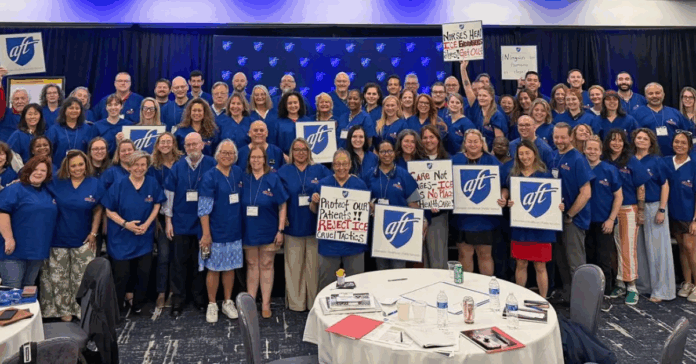The moral injury affecting caregivers in America’s hospitals and healthcare settings has only worsened in the first half of 2025. Tackling this crisis was the priority for activists from Connecticut as they joined their colleagues from across the country this summer for our national union’s annual healthcare professional issues conference (PIC). Together, they set a course for the coming year under a unifying theme of protecting patients, caring for communities and defending democracy.
Members of AFT Connecticut-affiliated local healthcare unions, as well as our state federation’s vice president and communications department staff, traveled to Chicago in mid June for the conference. They each contributed to an event focused on building power from within, amplifying strength through coalitions, exercising our rights and choosing democracy over autocracy.
“Sometimes it seems like only a small number of people are willing to be involved in making change,” said AFT Connecticut Vice President John Brady, RN (second row, sixth from left, in photo, above). “We learned that societies that have successfully pushed back on authoritarian régimes did so with an average of just 3.5% of their people actively engaged in the struggle. That shows how even a small number of dedicated people can make a difference,” added Brady, who co-chairs our national union’s healthcare program and policy council.
Brady’s comments referred to a pre-conference training session that walked activists through the mechanics of peaceful resistance – and which helped set the tone for the event. A veteran organizer who has run nonviolent‑action boot camps for social justice organizations across the country helped union members understand that mobilization is a skill anyone can master.
Theory was then turned into practice. Conference participants, wearing their AFT-branded scrubs, spilled into downtown Chicago that afternoon with handmade signs held high and joined a local protest aimed at defending vulnerable communities.
Attendees were welcomed by Chicago-based affiliate leader and national union vice president Stacey Davis Gates. She challenged activists to envision the labor movement’s work in organizing, mobilizing and negotiating as “revolutionary acts of bargaining for the common good.”
“Connecting well-being to collective action is key,” said Randi Schiavi, RN (fourth row, sixth from left, above), community outreach vice president of our affiliated University Health Professionals (UHP). “Unions and healthcare workers are on the same page about what improves someone’s life; financial security, access to quality, affordable healthcare, protected sick leave. Unions are more than a collection of benefits and financial advancement, they are the gateway to wellness by creating access to what is wrongfully withheld by corporations. Multiply our benefits by all the people in our community, and you see how we bargain for the common good,” she added.
The conference’s opening plenary featured renowned health‑policy analyst Dr. Vin Gupta on the impact of cuts to federal programs and funding for state and local services. A “know your rights” panel with advocates and the National Labor Relations Board (NLRB)’s former general counsel armed attendees with practical defenses against the increased criminalization of healthcare.
A plenary session brought labor leaders from across the country together to dissect recent organizing and collective bargaining victories in the healthcare sector. They told stories of ancillary staff securing voluntary union recognition and of nurses winning new contracts, both by averting a work stoppage as well as after being provoked to strike.
“The session sparked a conversation about carrying our momentum to the finish line in helping us negotiate our strongest contract to date,” said Hailey Jimenez, RN (second row, fifth from left), treasurer of our Backus Federation of Nurses. “We shared how our informational picket was a huge influence on shifting the tide at the bargaining table. It was crucial to engaging our community, putting our solidarity on full display and demonstrating a show of force that undoubtedly helped us win,” she added.
”We had the opportunity to share a fresh win of our own at the conference,” said UHP President Bill Garrity, RN (back row, sixth from left, above). “When UConn Health administrators let our current critical care recruitment and retention stipends expire, we mobilized the nearly 200 impacted nurses for a previously scheduled ‘town hall.’ Their voices were heard; management was forced to the table where we preserved the stipends for another year,” added Garrity, who also serves as AFT Connecticut’s vice president for healthcare.
National AFT President Randi Weingarten’s keynote addressed the broader challenges facing the entire labor movement, reminding attendees of the stakes for American democracy. She called on doctors, nurses and health professionals to unite with union members from all sectors against an encroaching autocracy bent on rolling back hard-won workplace rights.
The final panel featured AFT Connecticut Communications Coordinator Rosemary Rich and focused on the importance of “expert storytelling” in healthcare advocacy. She stressed how, as trusted members of the community, doctors, nurses and health professionals are uniquely positioned to be effective champions for a wide variety of policies impacting patients.
Between plenaries and speeches, workshops covered topics such as artificial intelligence (AI), advancing health equity, workplace violence prevention and immigration policy in the industry. Attendees were provided the tools for leading efforts to resolve the “Code RED” crisis afflicting the nation’s hospitals and health settings – as well as to secure a functional democracy.
Editor’s note: photo credit to Cesar Moreno Perez, AFT; additional contributions from Adrienne Coles, AFT.



